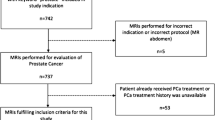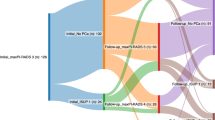Abstract
Introduction
To evaluate the clinical dilemma of men with surgical indication due to benign prostatic enlargement (BPE) and concomitant elevated PSA, we analysed if multiparametric magnetic resonance imaging (mpMRI) could safely prescind the prostate biopsy.
Methods
Forty men with surgical indication due to BPE and concomitantly elevated PSA levels were prospectively enrolled and retrospectively analysed. All patients underwent 1.5 Tesla mpMRI prior to TRUS-guided biopsies. In cases where mpMRI was PIRADS 3 with focal lesions, PIRADS 4 or PIRADS 5, additional fragments were obtained with the fusion guided technique. Biopsy histopathological results were used as the standard of reference.
Two scenarios were evaluated: scenario 1, considering mpMRI PIRADS 1 and 2 as negative; and scenario 2, considering PIRADS 1, 2 and 3 as negative. Clinically significant prostate cancer (CsPCa) was defined as ISUP ≥ 2.
Results
Median age was 68 years, median PSA was 9.41 (6.40–19.54) and median prostatic volume was 116.5 cc (IQR 86.5–155).
Scenario 1 mpMRI sensitivity, specificity, PPV, NPV and accuracy for any prostate cancer on prostate biopsy was 76.9%, 63%, 50%, 85% and 67.5%. For csPCa, they were 87.5%, 59.4%, 35%, 95% and 65%, respectively, for the same measures.
Scenario 2 the sensitivity, specificity, PPV, NPV and accuracy of mpMRI for any prostate cancer on prostate biopsy was 53.8%, 96.3%, 87.5%, 81.3% and 82.5%. For csPCa, they were 75%, 93.8%, 75%, 93.8% and 90%, respectively, for the same measures.
Conclusion
Prostate mpMRI may prevent unnecessary biopsies in patients with elevated PSA and surgical indications due to BPE, given its high negative predictive value.
Similar content being viewed by others
References
Platz EA, Smit E, Curhan GC, Nyberg LM, Giovannucci E. Prevalence of and racial/ethnic variation in lower urinary tract symptoms and noncancer prostate surgery in U.S. men. Urology. 2002;59(6):877-83.
Wroclawski ML, Carneiro A, Tristao RA, Sakuramoto PK, Youssef JD, Lopes Neto AC, et al. Giant prostatic hyperplasia: report of a previously asymptomatic man presenting with gross hematuria and hypovolemic shock. Einstein (Sao Paulo). 2015;13(3):420-2.
Catalona WJ, Southwick PC, Slawin KM, Partin AW, Brawer MK, Flanigan RC, et al. Comparison of percent free PSA, PSA density, and age-specific PSA cutoffs for prostate cancer detection and staging. Urology. 2000;56(2):255-60.
Kasivisvanathan V, Rannikko AS, Borghi M, Panebianco V, Mynderse LA, Vaarala MH, et al. MRI-Targeted or Standard Biopsy for Prostate-Cancer Diagnosis. N Engl J Med. 2018;378(19):1767-77.
Rosenkrantz AB, Kim S, Lim RP, Hindman N, Deng FM, Babb JS, et al. Prostate cancer localization using multiparametric MR imaging: comparison of Prostate Imaging Reporting and Data System (PI-RADS) and Likert scales. Radiology. 2013;269(2):482-92.
Epstein JI, Egevad L, Amin MB, Delahunt B, Srigley JR, Humphrey PA. The 2014 International Society of Urological Pathology (ISUP) Consensus Conference on Gleason Grading of Prostatic Carcinoma: Definition of Grading Patterns and Proposal for a New Grading System. Am J Surg Pathol. 2016;40(2):244-52.
Catalona WJ, Smith DS, Wolfert RL, Wang TJ, Rittenhouse HG, Ratliff TL, et al. Evaluation of percentage of free serum prostate-specific antigen to improve specificity of prostate cancer screening. Jama. 1995;274(15):1214-20.
Partin AW, Brawer MK, Subong EN, Kelley CA, Cox JL, Bruzek DJ, et al. Prospective evaluation of percent free-PSA and complexed-PSA for early detection of prostate cancer. Prostate Cancer Prostatic Dis. 1998;1(4):197-203.
Carter HB, Ferrucci L, Kettermann A, Landis P, Wright EJ, Epstein JI, et al. Detection of life-threatening prostate cancer with prostate-specific antigen velocity during a window of curability. J Natl Cancer Inst. 2006;98(21):1521-7.
Nam RK, Toi A, Klotz LH, Trachtenberg J, Jewett MA, Appu S, et al. Assessing individual risk for prostate cancer. J Clin Oncol. 2007;25(24):3582-8.
Ankerst DP, Hoefler J, Bock S, Goodman PJ, Vickers A, Hernandez J, et al. Prostate Cancer Prevention Trial risk calculator 2.0 for the prediction of low- vs high-grade prostate cancer. Urology. 2014;83(6):1362-7.
Schroder FH, Hugosson J, Roobol MJ, Tammela TL, Zappa M, Nelen V, et al. Screening and prostate cancer mortality: results of the European Randomised Study of Screening for Prostate Cancer (ERSPC) at 13 years of follow-up. Lancet. 2014;384(9959):2027-35.
Aminsharifi A, Howard L, Wu Y, De Hoedt A, Bailey C, Freedland SJ, et al. Prostate Specific Antigen Density as a Predictor of Clinically Significant Prostate Cancer When the Prostate Specific Antigen is in the Diagnostic Gray Zone: Defining the Optimum Cutoff Point Stratified by Race and Body Mass Index. J Urol. 2018;200(4):758-66.
Mussi TC, Garcia RG, Queiroz MR, Lemos GC, Baroni RH. Prostate cancer detection using multiparametric 3–tesla MRI and fusion biopsy: preliminary results. Int Braz J Urol. 2016;42(5):897-905.
Ahmed HU, El-Shater Bosaily A, Brown LC, Gabe R, Kaplan R, Parmar MK, et al. Diagnostic accuracy of multi-parametric MRI and TRUS biopsy in prostate cancer (PROMIS): a paired validating confirmatory study. Lancet. 2017;389(10071):815-22.
Truong H, Logan J, Turkbey B, Siddiqui MM, Rais-Bahrami S, Hoang AN, et al. MRI characterization of the dynamic effects of 5alpha-reductase inhibitors on prostate zonal volumes. Can J Urol. 2013;20(6):7002-7.
Kim JK, Lee HJ, Hwang SI, Choe G, Kim HJ, Hong SK. The effect of 5 alpha-reductase inhibitor therapy on prostate cancer detection in the era of multi-parametric magnetic resonance imaging. Sci Rep. 2019;9(1):17862.
Panebianco V, Barchetti G, Simone G, Del Monte M, Ciardi A, Grompone MD, et al. Negative Multiparametric Magnetic Resonance Imaging for Prostate Cancer: What’s Next? Eur Urol. 2018;74(1):48-54.
Oishi M, Shin T, Ohe C, Nassiri N, Palmer SL, Aron M, et al. Which Patients with Negative Magnetic Resonance Imaging Can Safely Avoid Biopsy for Prostate Cancer? J Urol. 2019;201(2):268-76.
Moon DG, Yu JW, Lee JG, Kim JJ, Koh SK, Cheon J. The influence of prostate volume on the prostate-specific antigen (PSA) level adjusted for the transition zone volume and free-to-total PSA ratio: a prospective study. BJU Int. 2000;86(6):670-4.
Author information
Authors and Affiliations
Corresponding author
Ethics declarations
Ethical standards
This study was approved by our local ethical committee (number 81449517.0.000.0071).
Additional information
Publisher's Note
Springer Nature remains neutral with regard to jurisdictional claims in published maps and institutional affiliations.
Rights and permissions
About this article
Cite this article
Wroclawski, M.L., Kayano, P.P., Amaral, B.S. et al. Can multiparametric magnetic resonance of the prostate avoid biopsies in patients with elevated PSA and surgical indication for benign prostatic enlargement?. Abdom Radiol 45, 3278–3282 (2020). https://doi.org/10.1007/s00261-020-02411-y
Published:
Issue Date:
DOI: https://doi.org/10.1007/s00261-020-02411-y




